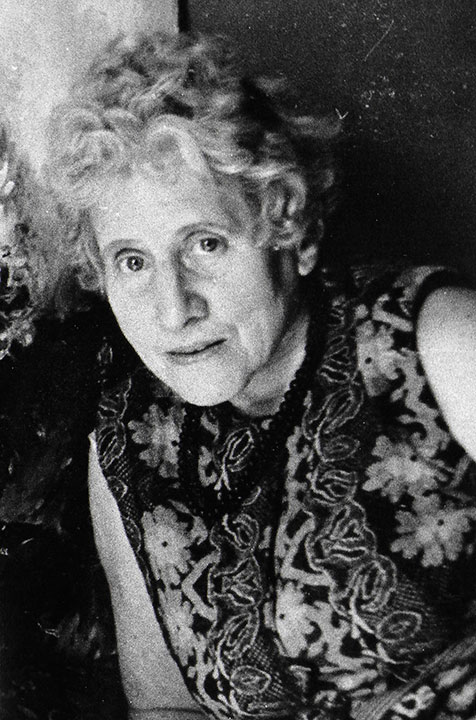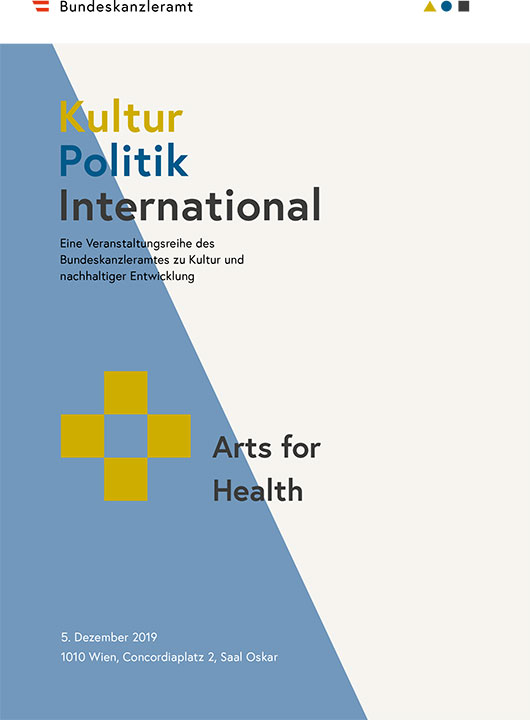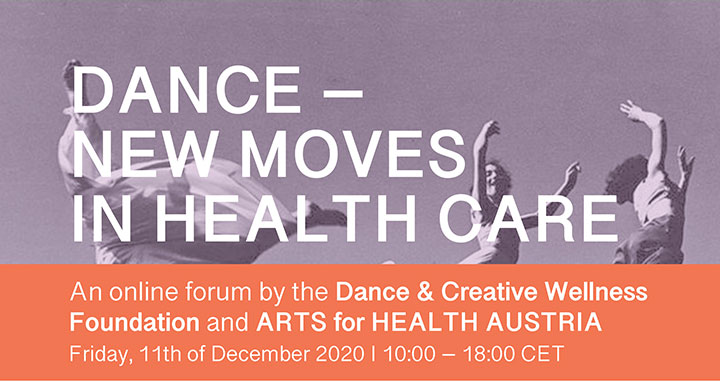![]() When, in December last year, the Austrian Federal Ministry of Arts and Culture initiated the workshop “Arts for Health” it was the first time that a policy institution addressed the topic. The workshop with over 90 participants met great interest and attracted artists, arts and stakeholders in the health sector. And it led to the foundation of the association ARTS for HEALTH AUSTRIA.
When, in December last year, the Austrian Federal Ministry of Arts and Culture initiated the workshop “Arts for Health” it was the first time that a policy institution addressed the topic. The workshop with over 90 participants met great interest and attracted artists, arts and stakeholders in the health sector. And it led to the foundation of the association ARTS for HEALTH AUSTRIA.
Austria has a long history of arts practices in the context of health and wellbeing. There are, for instance, the arts activities at a psychiatric hospital near Vienna that started in the 1950s. Some of the painting patients of this art brut, the Artists of Gugging, gained recognition on the international arts market. And eventually led to the establishement of the Gugging Museum.
However, in the debates with international colleagues from other European countries it becomes obvious that the development in Austria lacks behind. And this is mostly due to the lack of structures to represent the whole picture of “Arts for health and wellbeing”, to connect the stakeholders and to target the artistic initiatives with research.
 Early steps in the UK
Early steps in the UK
Dance interventions in the context of health and wellbeing have started as early as the 1980s. To be accurate, they date back to the beginnings of the 20th century when modern dance began to expand the repertory of the art of movement. Some Austrian dancers carried this legacy of “Ausdruckstanz” to other parts of the world.
For instance, Hilde Holger, a Viennese dancer who fled the Nazis and eventually settled in London. Hilde had a son with Down syndrome, who inspired her to work with disabled people, and she introduced her students to this work. One of them was Wolfgang Stange who established the first inclusive dance company in London. When I was studying at Laban I became a dancer in their first performance in 1981.
 Another dancer to engage in the work with people with disabilities was Gina Levete. But she went further. Together with a visual artist and a photographer she founded the organisation Shape in 1976 that acted as a sort of agency between institutions such as hospitals, prisons, care homes and artists. So, when I had my degree, I registered with Shape and they would call me if a suitable job came up. The demand was remarkable.
Another dancer to engage in the work with people with disabilities was Gina Levete. But she went further. Together with a visual artist and a photographer she founded the organisation Shape in 1976 that acted as a sort of agency between institutions such as hospitals, prisons, care homes and artists. So, when I had my degree, I registered with Shape and they would call me if a suitable job came up. The demand was remarkable.
… and in Austria
In Austria, up to today, everybody has to fight for himself. The image that presents itself to the outside world is one of flashlights. There is one project here, another initiative there, and only a few with a structure in place that allow them to develop a continuous and consistent programme.
One of them is “Ich bin O.K.”, founded in 1979 by the visionary physical therapist Katalin Zanin for people with Down Syndrome. “Ich bin OK” is now a dance school with daily classes in contemporary and urban dance styles with around 200 students. There is the inclusive “Ich bin OK Dance Company” featuring their most dedicated dancers, and they have established an education programme for inclusive dance teachers.
 Another example of a sustainable structure of adapted dance is “Tanz die Toleranz”. In 2007, Royston Maldoom was invited by the Catholic non-profit organisation Caritas to set up this Community Dance program. Royston, by the way, was another student of Hilde Holger. Tanz die Toleranz is engaging children and adults in the artistic process of working towards a dance performance. It especially addresses people from socially disadvantaged groups, immigrants and refugees and also realises projects for the elderly.
Another example of a sustainable structure of adapted dance is “Tanz die Toleranz”. In 2007, Royston Maldoom was invited by the Catholic non-profit organisation Caritas to set up this Community Dance program. Royston, by the way, was another student of Hilde Holger. Tanz die Toleranz is engaging children and adults in the artistic process of working towards a dance performance. It especially addresses people from socially disadvantaged groups, immigrants and refugees and also realises projects for the elderly.
The co-production association MAD (Mixed Abled Dance) has contributed significantly to the recognition of disability arts. It is run by and represents professional disability artists and promotes performances with renowned choreographers as well as workshops at schools. MAD is the recipient of the “Outstanding Artist Reward 2020” of the Austrian Federal Ministry for the Arts and Culture.
Apart from these long-standing examples there are a number of individuals who do remarkable work in the context of health and wellbeing, e.g. in the framework of Parkinson’s support groups or on the “free market”.
For the further development of the field there are two main issues: to find the cooperation of health institutions and, closely related to this, the financing. Mostly, it is the participants who pay for the classes, and only occasionally the funding is provided by a contracting body.
Thus, the dance work for health and wellbeing began in the UK and in Austria at about the same time. Now, NHS England is including arts provisions within the social perscription of their Universal Personalised Care, and arts programmes in a number of different setting are supported by research. Now, in Austria, the awareness and knowledge of the beneficial impact of arts and dance is still largely missing.
 One reason is also a huge difference in the approach of the cultural flagships that only hesitantly engage in sociocultural activities themselves. In the UK, companies like the Royal Ballet or the English National Ballet offer an extensive programs for different communities. So far, the Wiener Staatsballett has no comparable activities in place. Though, in the last two years, we managed a cooperation with the Wiener Staatsballett when Andrew Greenwood offered workshops of his method Switch2Move also to dancers of the Staatsballett.
One reason is also a huge difference in the approach of the cultural flagships that only hesitantly engage in sociocultural activities themselves. In the UK, companies like the Royal Ballet or the English National Ballet offer an extensive programs for different communities. So far, the Wiener Staatsballett has no comparable activities in place. Though, in the last two years, we managed a cooperation with the Wiener Staatsballett when Andrew Greenwood offered workshops of his method Switch2Move also to dancers of the Staatsballett.
It is therefore not surprising that in the discussions of the workshop “Arts for Health” of the Ministry for Arts and Culture, that I mentioned at the beginning, the call for a structure was a recurring theme. There is a need for a networking or umbrella organisation that should provide further education, the exchange between the artists and possibilities for work. Something, that Gina Levete put in place with SHAPE in London in 1976.
 A lot of other issues that came up in the workshop “Arts for Health” have to be worked on, and the overall understanding of adapted arts needs to be addressed and supported by research that provide a background for the practice.
A lot of other issues that came up in the workshop “Arts for Health” have to be worked on, and the overall understanding of adapted arts needs to be addressed and supported by research that provide a background for the practice.
And this is why we have founded the association
ARTS for HEALTH AUSTRIA (AfHA)
AfHA started its activities in December 2020 with the forum "Dance – New Moves in Health Care" in co-operation with the Dance & Creative Wellness Foundation.
AfHA aims to become
- A platform for arts-initiatives in the public health sector in Austria
- an agency for job opportunities for artists in the health sector
- an interface connecting the arts with science
- a national and international networking body
- an information centre for arts for health and wellbeing
- a provider of further education facilities
- a funding body for innovative arts projects in health care.
2021 should be a pilot year in which to devise concepts and action plans, to lay the foundations for developing a consulting agency and a support structure for the profession.
 With regard to dance, research should also provide a coherent understanding of the field, promote an historical awareness of the roots of dance in the context of wellbeing, that lead directly back to the dance scene of the early 20th century, and to Viennese dancers like Hilde Holger who inspired so many artists of the British community dance movement. In Austria, the trauma of the Nazi regime and its mis-use of the artistic movement of its time, has cut the links to this very creative dance past.
With regard to dance, research should also provide a coherent understanding of the field, promote an historical awareness of the roots of dance in the context of wellbeing, that lead directly back to the dance scene of the early 20th century, and to Viennese dancers like Hilde Holger who inspired so many artists of the British community dance movement. In Austria, the trauma of the Nazi regime and its mis-use of the artistic movement of its time, has cut the links to this very creative dance past.
ARTS for HEALTH AUSTRIA is here to revive it with new energy and a contemporary spirit!
PS: The author of this text is a founding member of AfHA. It was presented at the forum "Dance - New Moves in Health Care" on December 11, 2020.
Another article on this topic in German auf tanz.at: "Tanz ins Wohlbefinden"On FEbruary 10, 2021, AfHA was featured in the articel "Die süße Pille Kunst" in the Austrian daily newspaper Wiener Zeitung.

